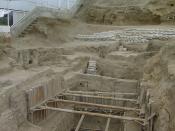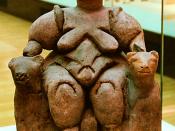Abstract: The following focuses on ÃÂatal Hüyük with an emphasis on the female figurines that have been found at the site. The figurines, originally interpreted as being religious idols for a Goddess cult, vary in size, shape and quality of design. The discussion that follows stems from this evidence. After a brief introduction to the site and the excavations at the site, I summarize Mellaart's original interpretations of the figurines. Following this, several other, more recent, interpretations of the figurines are presented. I hope to analyse the data and come to a conclusion as to whether or not there is sufficient evidence to support Mellaart's idea that a Goddess cult existed at this site.
**********
ÃÂatal Hüyük is a key site in the study of early urban centres in the Near East located in present day Turkey. The site, which dates to the early Neolithic, is one of the earliest sites where evidence for early agriculture and large-scale settlement has been found (Wolle 2002).
The 32 acre (13 hectares) site was densely occupied (Wolle 2002) and it has been estimated that the site supported anywhere from 1,650 to 10,000 people at one time (Gates 1996:284). Current estimates put the site's population near 5,000 based upon the density of houses across the site and by an estimation that four people occupied one house (Wolle 2002). The site is best known for its spectacular wall paintings and figurines that were uncovered inside the houses (Wolle 2002). The site, dating to around 9,400 - 8,400 years ago, exhibits incredible preservation, which has led so much attention toward the it (Wolle 2002).
Nine thousand years ago, visitors approaching the site from across a vast marshy plain would have seen hundreds of mud brick dwellings (Gates 1996:284). The rectangular, flat-roofed houses all shared walls that...

![Bahnhofstraße Salzbergen [_zwischen.Emsstraße.und.Poststraße_] ►1960◄](https://s.writework.com/uploads/1/12121/bahnhofstrase-salzbergen-zwischen-emsstrase-poststrase-1960-thumb.jpg)
